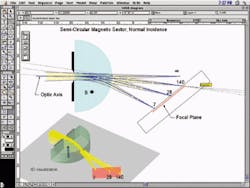Design and Applications: Instrument design benefits from computer assistance
FRED HERRERO
Instrument designers traditionally use detailed mathematical calculations to design mass spectrometers. The difficulty with this approach is that the complexity of the equations makes it easy to lose sight of basic geometrical design issues. So, while excellent instruments are developed using traditional methods, it can be difficult to identify alternate approaches that might reduce the size and magnetic moment of the instrument, which are crucial design factors for space missions.
I have developed the basic design for a new instrument, for use on an upcoming NASA mission, using an inexpensive computer-aided-design (CAD) system called VectorWorks (Diehl Graphsoft; Columbia, MD). Laying out the basic geometry in the CAD system made it possible think to geometrically rather than in equations. I was able to easily conceptualize the basic parameters of the design and evaluate alternate approaches simply by manipulating the geometry.
Space spectrometers
There are hundreds of applications for mass spectrometry applications in space exploration. The Orbital Mass Spectrometer Experiment was performed on Apollo flights 15 and 16, with the objective of measuring the composition and distribution of gases in the lunar atmosphere. A mass spectrometer in the Galileo probe directly and repeatedly sampled Jupiter's atmospheric gases at different altitudes as the probe descended. The Ion and Neutral Mass Spectrometer (INMS) is being used on the Cassini Mission, which lifted off on October 15, 1997. It measures positive ion and neutral species composition and structure in the upper atmosphere of Titan and magnetosphere of Saturn, and it will also measure the positive ion and neutral environments of Saturn's icy satellites and rings.
Space missions place stringent design demands on mass spectrometers. Typical laboratory instruments that range from the size of a microwave oven to that of a refrigerator are much too large. Besides small size, it is also important that the magnetic field exerted by the spectrometer be as small as possible to avoid interference with the attitude-control systems of the spacecraft, as well as other experiments. Our recently designed mass spectrometer is considerably lighter and has a smaller magnetic field than any previous magnetic sector instruments developed for use in space exploration
One of the most critical design issues was finding a magnetic section geometry for a mass spectrometer that could separate a reasonable ion mass range across a span of about one inch, the width of a typical microchannel plate detector. Our spectrometer is the first capable of resolving a wide range of masses with a package that can be as small as 1 x 2 x 0.75 in3. Rather than using the traditional hand calculation approach, the geometry for the new spectrometer was conceived in a graphical manner by manipulating lines and arcs in a CAD program. Using the program made it possible, for instance, to create lines tangent to arcs simply by moving the cursor near the arc and clicking on a tangent label on the computer screen.
Ionic trajectories
On this mass spectrometer project, we used the program to simulate ions moving on the same trajectory as they would be deflected by a magnet. The simulated ion paths varied depending on the molecular weight, because the program allowed us to quickly define arcs tangent to the original path of the ions with a radius that reflected their mass. We selected the endpoint of the line representing the original path simply by moving the cursor in that area and selecting the relevant construction—the endpoint of the line. The program locked the cursor onto the endpoint, and we then defined the arc and defined a line tangent to the arc simply by moving the cursor near the arc and selecting the tangent construction.
The ability to evaluate the impact of different magnetic sector geometries in minutes, rather than the hours or days that would have been required to perform the relevant computations, made it possible to quickly evaluate a wide range of alternatives. After graphically visualizing the impact of a number of different approaches, I had a hunch that a semicircular pattern might be effective in reducing the size and intensity of the required magnet. To test the hypothesis, I created a slightly convergent set of trajectories representing nonparallel ions entering the magnetic sector and noted that the influence of the semicircular magnetic sector caused ions of a similar mass to quickly converge onto the same trajectory (see figure).
Unique design
The unique aspect of this approach is that a conventional magnetic sectormass spectrometer requires that the ions be deflected over an arc of 180° in order to converge. My design, on the other hand, converges the ions within ±2° with a deflection less than 30°. This substantially reduces the amount of magnetic moment required, allowing the magnet to be considerably smaller. These design parameters are based on a sector diameter of 1.00 in., masses of 7, 28, 140 grams and infinite mass with corresponding trajectory radii of 1.0, 2.00, and 4.472 in., and an infinite radius that corresponds to a straight line. The magnetic induction required to achieve these trajectory radii is 8000 Gauss, and the ion energy is 2825 eV.
The first version of this mass spectrometer was flown in a recent rocket experiment to study narrow layers of ionization formed in the Earth's ionosphere between 120 and 200 km altitude. These layers are believed to be less than 1 km in thickness; the high sensitivity afforded by this design is essential as the rocket flies through the layer with a vertical velocity of about 500 meters per second.
Overall, the improved visualization provided by the use of CAD to replace mathematical equations in the initial stages of instrument design gave us a simple, quick, and graphical way to evaluate ionic trajectories thereby saving time and leading to more-creative designs.
Fred Herrero is the Explorer Technology Program manager at NASA/Goddard Spaceflight Center, Code 710.2, Greenbelt, MD 20771.
